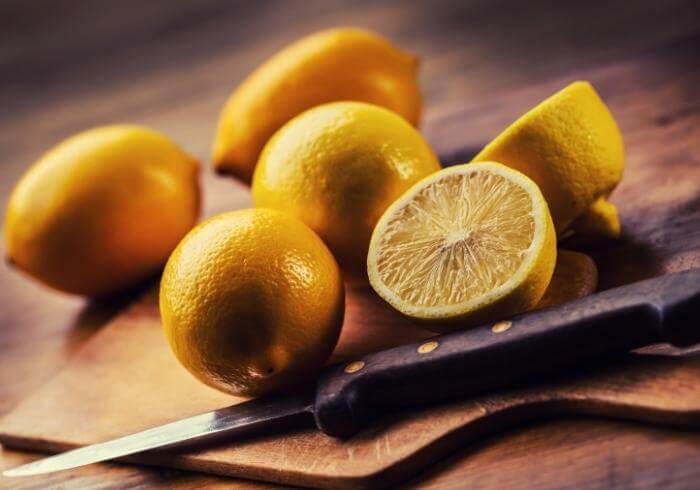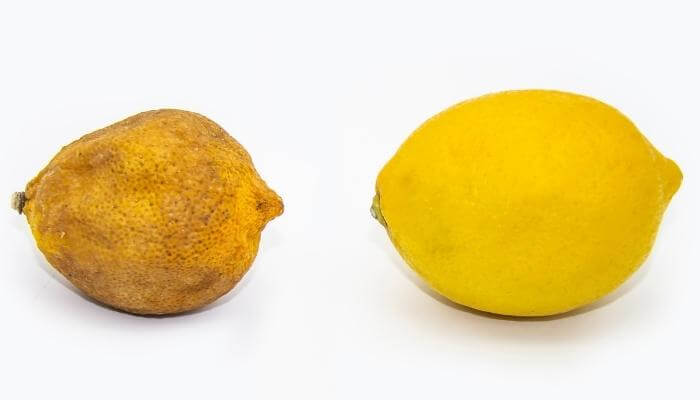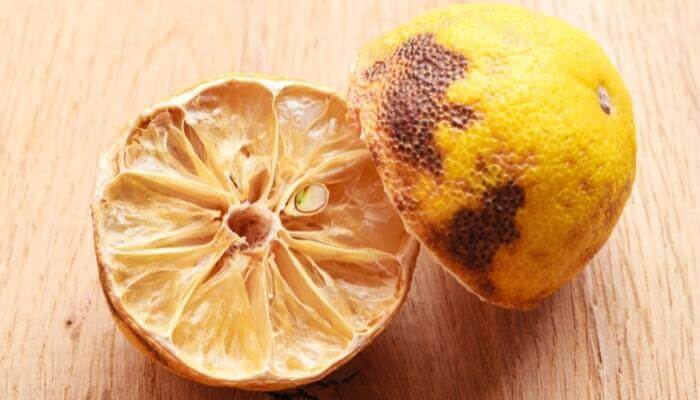Lemons are one of the most interesting fruits in the kitchen. Not only do they add a tart and acidic flavor to food, but they’re also great for cleaning and disinfecting. But what should you do if you’ve got a bad lemon on your hands?
The way to tell if a lemon is bad is by looking at it. A hard, wrinkled lemon, has patches of discoloration, including green or white mold, or is very squishy indicates that it has spoiled. It is best to throw out a bad lemon and check for signs of spoilage on nearby fruits.

Let’s look at other ways to tell if a lemon is bad.
How To Know If A Lemon Is Bad
The Lemon Is Too Hard
Are hard lemons still good? Some hard lemons may be good and simply hard as the result of being picked too early. Many fruits are picked early and left to ripen on the truck, which can affect the fruit dramatically.
It’s best to avoid using lemons that don’t have some give to them. They’ll often yield less lemon juice and not give you the flavor you expect, more bitter than sour-sweet.

At some point, a wrinkled lemon will become hard. So, wrinkled lemons are best to add to your compost bin.
While lemons have some natural wrinkles, ones that have lost their luster have lost a lot of moisture, and the decaying process has been long underway.
The Lemon Is Squishy
A squishy lemon could indicate severe bruising or one that has already spoiled and is no longer safe to consume. Another reason could be that it was picked too late and allowed to over-ripen on the tree. You will need to proceed with caution, but tossing it out is the safer choice.
Are Soft Lemons Bad? Not necessarily. Some lemons are naturally softer than others, depending on their species, growing environment, and handling. I love softer lemons because it means that I can extract more juice from them.
It Has Patches Of Discoloration
Green or white patches on a lemon indicate mold and spoilage. Often you will see this spread to the lemons around it. You should never use a lemon that looks like this and toss it out immediately. Any affected lemons nearby should also be thrown out as a precautionary measure.
White Spots on lemons could be caused by powdery mildew or mold that affects many citrus trees or damage to the lemon that is exposing the pith from underneath the skin.
The USDA recommendation is to discard soft high-moisture fruits with mold but allow hard fruits if you cut around the mold at least one inch away from it. A lemon is a mix of both, so what do you do? When in doubt, you get rid of it.
If the damage to your lemon is fresh, it may be safe to consume, but realize that this is a potential area for bacteria to thrive, so it will need to be used immediately.
Brown spots on lemons could indicate that they have been infected by a fungus-like citrus canker or rust mites or simply starting to rot and need to be tossed out.
The USDA says while it might be unsightly, citrus canker is not harmful to humans and is safe to eat.
If your lemon just looks a little dirty, it could be from rough handling and is probably fine if all signs check out.
The Lemon Is Brown On The Inside
Brown rust spots inside a lemon can be caused by pests, growing conditions, or spoilage.
Spoilage will often accompany one of the other signs, while pests are much more difficult to figure out since many can be hard to spot. If you’re not sure, get rid of it instead of spoiling your recipe.
A lemon that is brown on the inside can be from nutrient deficiencies during the growing phase of its life. While it may be safe to consume, the flavor and texture may not suit your purposes.
The Flavor Is Bad Or Weak
A bad lemon will have a bad taste, and a weak-tasting lemon is on its way out shortly. I’m not sure why you would want to use such a lemon, so discard it and use a fresh one instead.
A bad lemons acidity will change as bacteria metabolize and break it down, affecting the flavor from sweet to bitter.
It Has A Smell
A fresh lemon shouldn’t smell like much of anything until you cut into the skin, where you can expect that punchy citrus smell.
A bad lemon will certainly smell off and often smell moldy. You should never use a lemon that smells even slightly off. For the price of a fresh lemon and your delicious recipe, it’s best to get rid of the old smelly one.
What Does A Bad Lemon Look Like?
Let me show you a comparison of a bad lemon and a good one so you can see some signs for yourself.
Whole Good vs Bad Lemon
The good lemon looks firm, and the skin is bumpy-smooth with vibrant yellow color and shines from the light. This is perfect for making lemon zest!

The bad lemon looks soft, deflated, and the skin is wrinkled with patches of discoloration from green and white mold.
Inside Good vs Bad Lemon
The good lemon inside has a translucent yellow and juicy look while the seeds are whiteish-brown, and the pith is white.

Inside the bad lemon are brown patches, the translucent yellow is dull, the fibers in the lemon are dry and separating, and the skin has brown patches and looks unappetizing.
As you can see, it’s not difficult to tell the difference between a good lemon and a bad lemon.
Bad Lemon FAQs
Can Old Lemons Make You Sick?
Yes, old lemons can make you sick if they are moldy or contain enough spoilage bacteria. Lemons are highly acidic, which makes them an inhospitable environment for most bacteria, but not all.
Are Brown Spots On Lemons Safe To Eat?
Brown spots on lemons may be safe to eat, but if the brown spots are from spoilage, then the lemon is not safe to consume and should be thrown out.
Are White Spots On Lemons Safe To Eat?
If white spots are caused by citrus powdery mildew and not fuzzy mold, it’s likely safe for human consumption. However, it could cause an allergic reaction for some. Don’t use it if you are unsure.
Are Moldy Lemons Safe To Eat?
No, you should never eat a moldy lemon, as it can make you sick. Moldy lemons should be thrown out.
Why Does My Lemon Look Dirty?
Your lemon may look dirty from handling or storage. If the lemon looks otherwise fine, it should be safe to eat.
What Can You Do With Bad Lemons?
I don’t recommend using bad lemons for cleaning purposes, even if they are still acidic. Consider the bacteria you might be spreading around. Instead, you can compost moldy or bad lemons.











